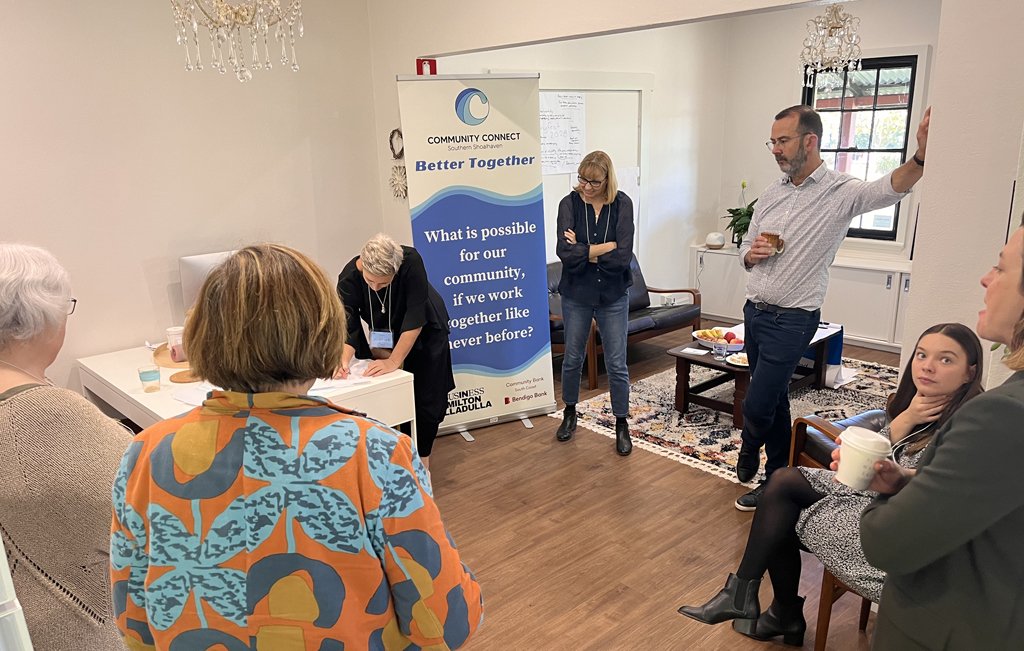Knitted Stories
Julie Bozza considers another form of storytelling
7 March 2023
The StoryFest Inc committee has held two planning days at the Treading Lightly Hub in Milton. Treasurer Julie Bozza was inspired by more than just the words and camaraderie!
I was inspired to write this piece by something I found at the Treading Lightly Hub, on Myrtle Street in Milton. The StoryFest committee has held a few significant meetings in this light and welcoming space, from Strategy Planning Days to our AGM. The casual chic combination of comfy chairs and chandeliers seems to suit us!
Hanging from a hook on the wall is an unassuming object: a knitted scarf in stripes of red and blue, crafted in simple garter stitch. Despite being an ardent knitter myself, I didn’t pay it much mind at first. But then I looked closer at the label attached beside it:
Climate Scarf: 101 years of Global Warming
This modest, everyday item was suddenly packing a punch.
The scarf provides a vivid tale of our world’s warming climate from 1919 to 2019. The progression of colour – from dark blue at one end, through various cool colours to light yellows about two-thirds of the way, and finally to dark red at the other end – was not down to a knitter’s random choices.
There is a story told here, and given that we’re now living in the dark red years, it’s not a comfortable one!
The Climate Scarf was given to the Treading Lightly Hub by our local “loop” of the Knitting Nannas, “an international disorganisation where people come together to ensure that our land, air and water are preserved for our children and grandchildren”. They can be seen once a month by the Ulladulla Harbour, dressed in bright yellow and black, and sitting, knitting and plotting for our future.
Further browsing took me to Common Grace and their Knit for Climate Action campaign. On Show Your Stripes Day, 21 June 2021, this campaign gifted Climate Scarves to each of Australia’s Federal MPs and Senators.
Common Grace’s knitting pattern was based on climate data provided by Professor Ed Hawkins, provided free for all to use. If you visit his site, the main graph shows temperatures combined from around the globe, but you can drill down to regions, such as New South Wales or Tonga or the South Pacific Ocean. There are local variations, but the overall story unfortunately remains the same.
All of which brought home to me yet again how many ways a story can be told!
Knitting Stories Together
Knitting has been used to pass coded messages during war, as well as to convey meaning via traditional gansey patterns, Celtic knots, lace designs based on wedding dates, and so on. I know a knitter who designed her own sweaters to express rude things in Morse code. (Which may well have saved her from the unemployment queue!)
This is only a glimpse of the possibilities of storytelling via arts and crafts…
Our own StoryFest event is about celebrating storytelling – not only the stories told through reading and writing books (though we love books!) but also stories told through music and poetry performances, comedy, gardening and cooking, and illustrations.
We hope you’ll join us in June 2023 to share in the joy and variety of storytelling!
To find out more about Common Grace and the Climate Scarf, visit their Knit for Climate Action webpage.
Explore the Show Your Stripes data from Ed Hawkins (Professor of Climate Science, University of Reading, UK) at showyourstripes.info



